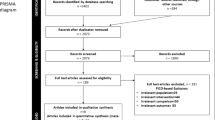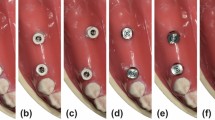Abstract
This narrative review aims to study the accuracy of different intra-oral scanner (IOS) devices already available on the market. The accuracy emerged during in vitro, in vivo and ex vivo studies made with IOS devices during the scan of a full arch implant rehabilitation that have been analysed to evaluate which device may be the most suitable in this clinical situation. The literature review was performed by searching topics and keywords using the PubMed and Medline databases, for example, ‘digital workflow', ‘full arch', ‘full arch implant rehabilitation' and ‘accuracy of IOS'. Inclusion and exclusion criteria for studies were: correct IMRAD (introduction, methods, results and discussion) structure; article with clear and detailed objectives; consistency of the articles with the purpose of the review; two-year range from the year of publication of the article; reproducible materials and methods; and correct follow-up. Most of the intra-oral scanners employed in vitro provided acceptable accuracy (below a threshold of 150 μm). The main parameters identified for their influence on precision were interim plant distance, body scan design, scanning pattern and operator experience. Even though literature is limited, significant differences emerged between the different models of intra-oral scanners evaluated in the studies considered within this review.
Key points
-
The narrative review highlights that most of the intra-oral scanners studied in vitro demonstrated acceptable accuracy, with deviations below a threshold of 150 μm. This finding is crucial, as it indicates that these devices can reliably capture detailed data during the scan of a full arch implant rehabilitation.
-
The review identifies several key parameters that influence the precision of intra-oral scanners. These factors include interim implant distance, body scan design, scanning pattern and operator experience. Understanding and optimising these variables can lead to improved accuracy and better clinical outcomes in full arch implant rehabilitation cases.
-
The paper emphasises significant differences between the various models of intra-oral scanners assessed in the studies. This insight is valuable for dental professionals as it helps them make informed decisions about choosing the most suitable intra-oral scanner device for specific clinical situations, such as full arch implant rehabilitation, based on its demonstrated accuracy and performance in relevant studies.
This is a preview of subscription content, access via your institution
Access options
Subscribe to this journal
Receive 24 print issues and online access
$259.00 per year
only $10.79 per issue
Buy this article
- Purchase on Springer Link
- Instant access to full article PDF
Prices may be subject to local taxes which are calculated during checkout

Similar content being viewed by others
References
Chochlidakis K, Papaspyridakos P, Tsigarida A et al. Digital Versus Conventional Full-Arch Implant Impressions: A Prospective Study on 16 Edentulous Maxillae. J Prosthodont 2020; 29: 281-286.
Michelinakis G, Apostolakis D, Kamposiora P, Papavasiliou G, Özcan M. The direct digital workflow in fixed implant prosthodontics: a narrative review. BMC Oral Health 2021; 21: 37.
Imburgia M, Kois J, Marino E, Lerner H, Mangano F G. Continuous Scan Strategy (CSS): A Novel Technique to Improve the Accuracy of Intraoral Digital Impressions. Eur J Prosthodont Restor Dent 2020; 28: 128-141.
Papaspyridakos P, Chochlidakis K, Kang K et al. Digital Workflow for Implant Rehabilitation with Double Full-Arch Monolithic Zirconia Prostheses. J Prosthodont 2020; 29: 460-465.
Papaspyridakos P, De Souza A, Bathija A, Kang K, Chochlidakis K. Complete Digital Workflow for Mandibular Full-Arch Implant Rehabilitation in 3 Appointments. J Prosthodont 2021; 30: 548-552.
García-Gil I, Cortés-Bretón-Brinkmann J, Jiménez-García J, Peláez-Rico J, Suárez-García M-J. Precision and practical usefulness of intraoral scanners in implant dentistry: A systematic literature review. J Clin Exp Dent 2020; 12: 784-793.
Di Fiore A, Meneghello R, Savio G, Graiff L, Monaco C, Stellini E. Influence Of Three Different Scanning Techniques In Full-Arch Implants Digital Impression Using Intraoral Scanners: A Randomized Controlled Cross-Over Trial. EURAS J Health 2020; 1: 37-50.
Huang R, Liu Y, Huang B, Zhang C, Chen Z, Li Z. Improved scanning accuracy with newly designed scan bodies: An in vitro study comparing digital versus conventional impression techniques for complete-arch implant rehabilitation. Clin Oral Implants Res 2020; 31: 625-633.
Ahmed W M, Verhaeghe T V, McCullagh A P. Maxillary complete-arch implant-supported restoration: A digital scanning and maxillomandibular relationship workflow. J Prosthet Dent 2021; 125: 216-220.
Wulfman C, Bonnet G, Carayon D et al. Digital removable complete denture: a narrative review. French J Dent Med 2020; DOI: 10.36161/FJDM.0005.
Lerner H, Mouhyi J, Admakin O, Mangano F. Artificial intelligence in fixed implant prosthodontics: a retrospective study of 106 implant-supported monolithic zirconia crowns inserted in the posterior jaws of 90 patients. BMC Oral Health 2020; 20: 80.
Lerner H, Hauschild U, Sader R, Ghanaati S. Complete-arch fixed reconstruction by means of guided surgery and immediate loading: a retrospective clinical study on 12 patients with 1 year of follow-up. BMC Oral Health 2020; 20: 15.
Mizumoto R M, Yilmaz B, McGlumphy E A Jr, Seidt J, Johnston W M. Accuracy of different digital scanning techniques and scan bodies for complete-arch implant-supported prostheses. J Prosthet Dent 2020; 123: 96-104.
Zhang Y-J, Shi J-Y, Qian S-J, Qiao S-C, Lai H-C. Accuracy of full-arch digital implant impressions taken using intraoral scanners and related variables: A systematic review. Int J Oral Implantol (Berl) 2021; 14: 157-179.
Mangano F G, Bonacina M, Mandelli F, Marchiori F. Solid index versus intraoral scanners in the full-arch implant impression: in vitro trueness evaluation. BMC Res Notes 2020; 13: 504.
Pesce P, Bagnasco F, Pancini N et al. Trueness of Intraoral Scanners in Implant-Supported Rehabilitations: An In Vitro Analysis on the Effect of Operators' Experience and Implant Number. J Clin Med 2021; 10: 5917.
Mangano F G, Admakin O, Bonacina M, Lerner H, Rutkunas V, Mangano C. Trueness of 12 intraoral scanners in the full-arch implant impression: a comparative in vitro study. BMC Oral Health 2020; 20: 263.
Goracci C, Franchi L, Vichi A, Ferrari M. Accuracy, reliability, and efficiency of intraoral scanners for full-arch impressions: a systematic review of the clinical evidence. Eur J Orthod 2016; 38: 422-428.
Sami T, Goldstein G, Vafiadis D, Absher T. An in vitro 3D evaluation of the accuracy of 4 intraoral optical scanners on a 6-implant model. J Prosthet Dent 2020; 124: 748-754.
Roig E, Garza L C, Álvarez-Maldonado N et al. In vitro comparison of the accuracy of four intraoral scanners and three conventional impression methods for two neighboring implants. PLoS One 2020; DOI: 10.1371/journal.pone.0228266.
Dutton E, Ludlow M, Mennito A et al. The effect different substrates have on the trueness and precision of eight different intraoral scanners. J Esthet Restor Dent 2020; 32: 204-218.
Revell G, Simon B, Mennito A et al. Evaluation of complete-arch implant scanning with 5 different intraoral scanners in terms of trueness and operator experience. J Prosthet Dent 2022; 128: 632-638.
Resende C C, Barbosa T A, Moura G F et al. Influence of operator experience, scanner type, and scan size on 3D scans. J Prosthet Dent 2021; 125: 294-299.
Bilmenoglu C, Cilingir A, Geckili O, Bilhan H, Bilgin T. In vitro comparison of trueness of 10 intraoral scanners for implant-supported complete-arch fixed dental prostheses. J Prosthet Dent 2020; 124: 755-760.
Canullo L, Colombo M, Menini M, Sorge P, Pesce P. Trueness of Intraoral Scanners Considering Operator Experience and Three Different Implant Scenarios: A Preliminary Report. Int J Prosthodont 2021; 34: 250-253.
Revilla-León M, Jiang P, Sadeghpour M et al. Intraoral digital scans: Part 2 - influence of ambient scanning light conditions on the mesh quality of different intraoral scanners. J Prosthet Dent 2020; 124: 575-580.
Wulfman C, Naveau A, Rignon-Bret C. Digital scanning for complete-arch implant-supported restorations: A systematic review. J Prosthet Dent 2020; 124: 161-167.
Neto A D, de Moura E Costa A J, Choi I G et al. Digital Workflow for Full-Arch Implant-Supported Prosthesis Based on Intraoral Scans of a Relative of the Patient. J Oral Implantol 2021; 47: 68-71.
Carneiro Pereira A L, Pinto Campos M F, Porto de Freitas R F et al. Partially digital workflow for making complete-arch implant-supported fixed prostheses: A dental technique. J Prosthet Dent 2023; 129: 18-23.
Arcuri L, Pozzi A, Lio F, Rompen E, Zechner W, Nardi A. Influence of implant scanbody material, position and operator on the accuracy of digital impression for complete-arch: A randomized in vitro trial. J Prosthodont Res 2020; 64: 128-136.
Schmalzl J, Róth I, Borbély J, Hermann P, Vecsei B. The impact of software updates on accuracy of intraoral scanners. BMC Oral Health 2023; 23: 219.
Paratelli A, Vania S, Gómez-Polo C, Ortega R, Revilla-León M, Gómez-Polo M. Techniques to improve the accuracy of complete-arch implant intraoral digital scans: A systematic review. J Prosthet Dent 2021; 129: 844-854.
Author information
Authors and Affiliations
Contributions
Chiara De Rubertis, Franco Ferrante, Nicolò Stefanelli, Marco Friuli, Marta Madaghiele, Christian Demitri and Andrea Palermo have made substantial contributions to the conception or design of the work or the acquisition, analysis, or interpretation of data; has approved the submitted version (and version substantially edited by journal staff that involves the authors' contribution to the study); agrees to be personally accountable for their own contributions; and ensures that questions related to the accuracy or integrity of any part of the work, even ones in which the author was not personally involved, are appropriately investigated, resolved and documented in the literature. All authors have read and agreed to the published version of the manuscript.
Corresponding author
Ethics declarations
The authors declare no competing interests.
Rights and permissions
Springer Nature or its licensor (e.g. a society or other partner) holds exclusive rights to this article under a publishing agreement with the author(s) or other rightsholder(s); author self-archiving of the accepted manuscript version of this article is solely governed by the terms of such publishing agreement and applicable law.
About this article
Cite this article
De Rubertis, C., Ferrante, F., Stefanelli, N. et al. The accuracy of intra-oral scanners in full arch implant rehabilitation: a narrative review. Br Dent J 235, 887–891 (2023). https://doi.org/10.1038/s41415-023-6550-x
Received:
Revised:
Accepted:
Published:
Issue Date:
DOI: https://doi.org/10.1038/s41415-023-6550-x



